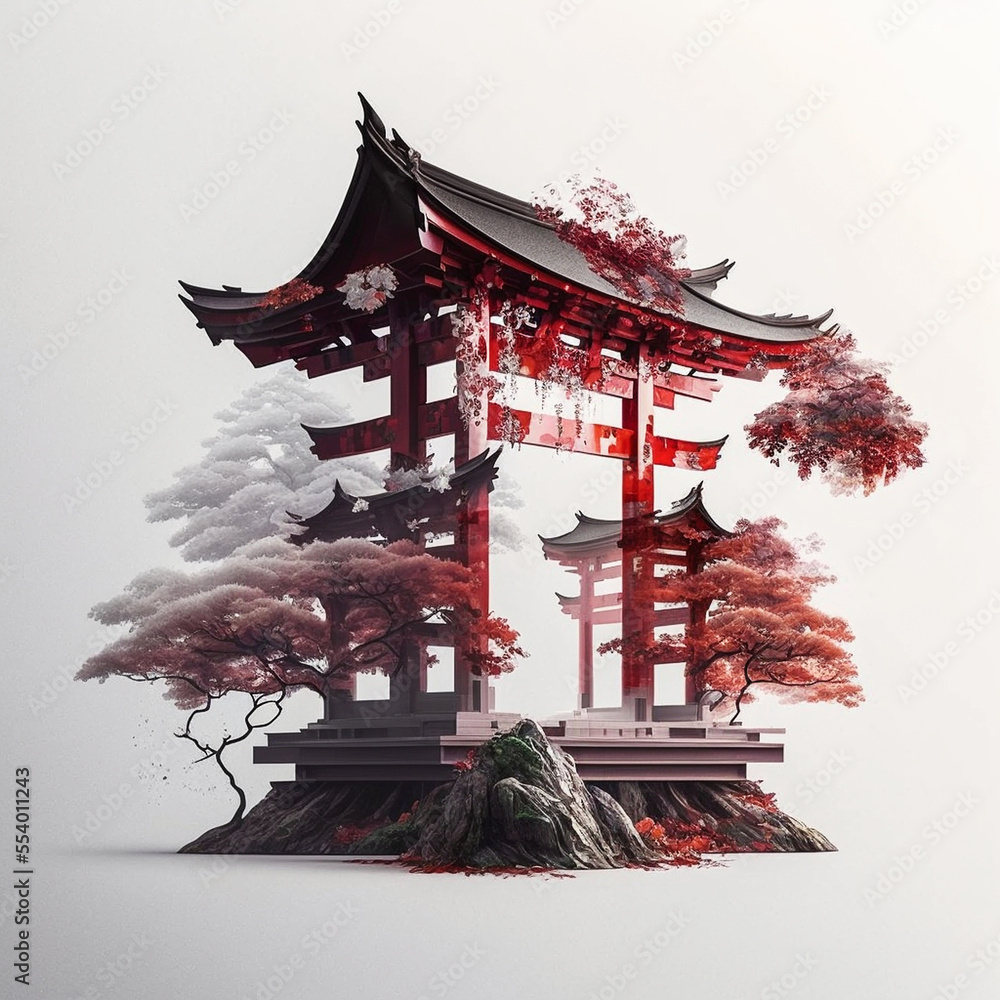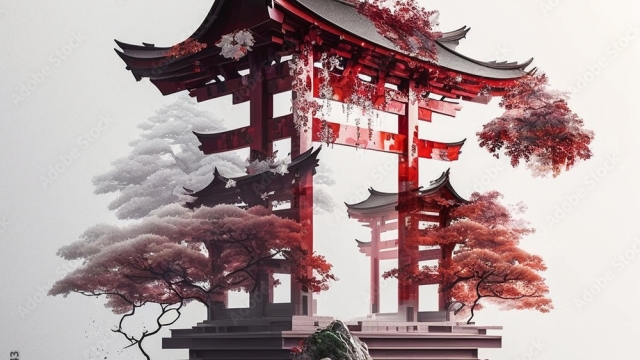
In the serene landscapes of Japan, where nature harmonizes with spirituality, Shinto shrines stand as sacred gateways connecting the physical world with the divine. These enchanting structures, often nestled among ancient trees or overlooking tranquil waters, invite visitors to step into a realm where tradition and reverence intertwine. Each shrine, uniquely adorned with its own architectural style and spiritual significance, tells a story that resonates deeply with the heart of Japanese culture.
Shinto Shrines In Japan
As we explore the beauty and spirituality of Shinto shrines, we uncover not only their aesthetic allure but also the profound beliefs that underpin them. The simplicity of a torii gate or the intricate details of a honden reflect the rich tapestry of Shinto, Japan’s indigenous faith, which honors kami, the spirits of nature and ancestors. Through the rituals, festivals, and everyday offerings made at these sites, we witness the enduring connection between humanity and the divine, revealing a path of peace and reflection that continues to inspire countless souls.
Historical Significance of Shinto Shrines
Shinto shrines, known as jinja in Japanese, are deeply intertwined with the cultural and spiritual fabric of Japan. They serve as sanctuaries where the kami, or spirits, are revered. The origins of Shinto shrines can be traced back to ancient Japan, before the arrival of Buddhism, making them a crucial aspect of the country’s indigenous spirituality. These sites symbolize a profound connection to nature and the ancestors, reflecting the beliefs of a society rooted in harmony with its environment.
Historically, Shinto shrines have played a vital role in the community, acting as centers for local festivals, agricultural rituals, and communal gatherings. The architectural styles of these shrines evolved over centuries, influenced by the political and social changes in Japan. The famous torii gates that mark the entrance to many shrines signify the transition from the mundane to the sacred, establishing a space where visitors can engage with the divine. Each shrine is unique, often embodying regional characteristics and historical narratives that enrich the national tapestry of Japan.
The significance of Shinto shrines extends beyond mere architecture or ritual. They are living testaments to Japan’s history, embodying the beliefs and practices of generations. The preservation of these sites is crucial, as they offer insight into the relationship between the Japanese people and their spiritual heritage. Today, Shinto shrines continue to attract millions of visitors, inviting them to experience the timeless beauty and spirituality that define this ancient tradition.
Architectural Elegance and Design
The architectural elegance of Shinto shrines is deeply rooted in their connection to nature and spirituality. Unlike many other religious structures, Shinto shrines are designed to harmonize with their surroundings, often blending seamlessly into the landscapes they inhabit. This thoughtful integration reflects the Shinto belief in kami, or spirits, that reside in natural elements. The use of natural materials, such as wood and stone, further enhances this connection, creating an environment that feels alive and sacred.
Typical features of Shinto shrine architecture include wooden structures with raised floors, thatched roofs, and elaborate torii gates that mark the transition from the mundane to the sacred. The torii gate, often painted in vibrant vermilion, serves as a symbolic threshold, inviting visitors to enter a realm of spiritual significance. The asymmetrical design of shrine buildings, often characterized by layered roofs and ornate carvings, not only showcases the craftsmanship of the time but also adds to the visual appeal and reverence of these spaces.
In addition to their aesthetic beauty, Shinto shrines are carefully designed to promote a sense of peace and reflection. Pathways leading to the shrine are typically lined with trees or stone lanterns, encouraging a contemplative journey. The overall layout is intended to guide visitors as they approach the sacred space, creating an atmosphere of anticipation and serenity. This architectural harmony fosters a deep connection to the spirituality of the site, allowing individuals to immerse themselves fully in the experience of worship and reverence.
Spiritual Practices and Rituals
Shinto shrines serve as vital centers for spiritual practices and rituals that connect the community with the divine. Visitors often begin their journey by performing a purification ritual at the temizuya, a water basin located near the shrine entrance. This act of cleansing, which involves washing the hands and mouth, symbolizes the removal of impurities and prepares one for entering a sacred space. It reflects the fundamental Shinto belief in maintaining a pure spirit to communicate effectively with the kami, or deities, honored at these sites.
Regular ceremonies occur throughout the year, often coinciding with seasonal festivals that celebrate nature and agricultural cycles. These rituals may include offerings of rice, sake, and seasonal fruits, reflecting gratitude for the bounties received. Additionally, special ceremonies may mark significant life events such as birth, coming-of-age, and marriage, which strengthen the bond between individuals and the kami. Through these rituals, the community reaffirms its connection to its spiritual heritage and the natural world.
Visitors to Shinto shrines can also participate in personal prayers or wishes, known as norito. Many write their hopes or concerns on wooden plaques called ema, which they hang at the shrine in the hopes that the kami will hear their requests. The tranquility and beauty of the shrine grounds enhance the spiritual experience, inviting moments of reflection and a deeper appreciation for the interconnectedness of life and nature. Through these practices, Shinto shrines nurture a sense of spirituality that resonates with both locals and visitors alike.
Nature and Environment in Shintoism
Nature holds a sacred place in Shinto belief, reflecting the deep reverence for the natural world that is central to the faith. Shinto shrines are often located in beautiful, natural settings, whether nestled within ancient forests, near mountains, or beside rivers. These locations are chosen not just for their beauty but for their spiritual significance, as they are believed to embody kami, the spirits that inhabit the natural elements. Rituals and practices within Shinto emphasize harmony with nature, encouraging believers to cultivate a respectful and nurturing relationship with the environment.
The appreciation of nature in Shintoism is expressed in various ways, including festivals that celebrate seasonal changes and the bounty of the earth. For instance, matsuri, the traditional festivals held at shrines, often involve offerings of rice, fruits, and vegetables, acknowledging and honoring the kami that grant these blessings. Such events serve as reminders of the interconnectedness of life and the gratitude that Shinto practitioners feel toward the natural world. This connection fosters a sense of stewardship, promoting conservation and a sustainable approach to living in harmony with nature.
Moreover, the aesthetic elements of Shinto shrines, including the use of natural materials like wood and stone, reflect the belief in simplicity and the beauty of the unadorned world. The architecture harmonizes with the surrounding landscape, creating spaces that invite contemplation and connection. This design philosophy encourages visitors to immerse themselves in the environment, to listen to the whispers of the ancients, and to find spiritual renewal in the presence of nature. In this way, Shinto shrines serve not only as places of worship but also as sanctuaries for the soul, embodying the beauty and spirituality of the natural world.
